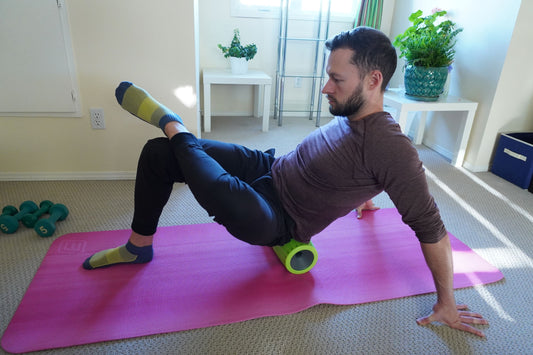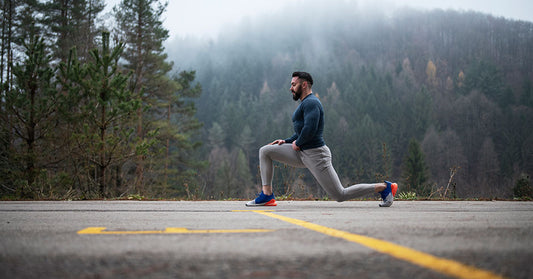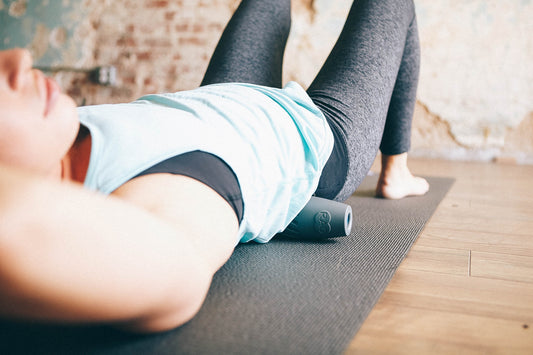As the director of clinical operations for OrthoCarolina, David Little has seen plenty of athletes stopped in their tracks by injury. But it was his own recurring problems that taught him the valuable lesson of patient patience and the power of the simplest treatments. David shares with us his tactics for pulling through the mental challenges of injury recovery, and what he wishes every runner knew about recovery.
Besides your clinical training you have a lot of personal experience in athletics and injury recovery.
I was pretty athletic growing up. Played a lot of soccer, which unfortunately is one of the main reasons I got into orthopedics. I had a lot of orthopedic injuries. I went through four ACL’s on my right knee and had two more surgeries after that. In total I had six knee surgeries. After the knee surgeries I hung up the soccer cleats but continued to run. Just doing 5K’s, half marathons, trail runs, that sort of thing.
How did those injuries affect you, personally?
Initially, the knee surgeries were a tough one for me. I’ve always been an outdoors person, always on my feet. Always wanting to be in the woods, always running. After the 4th knee surgery I never fully recovered after that. I would still run, and kind of push myself through it, but for a few days after a race I’d be swollen and had a hard time getting that full extension back.
Why do you think you kept running?
They talk about the runner’s high—I truly believe you get a runner’s high. I tend to exercise not just to stay in physical shape. It’s more for the mental shape. My wife always knows when I’m not working out because I’m acting out. It’s a stress reliever. A place to focus all that energy. Everyone kept telling me to stop running because of the knee surgeries.

And the knees weren’t the only problem?
Just recently I started having some lower back issues. I had a pretty significant herniated disk. I had to have spine surgery last December. The recovery from that wasn’t too terribly bad. We had a half marathon we were doing in Alaska. I recovered quickly and was able to do that. The back trouble came back soon after.
When I started having the spine issues, that’s when I sat down with myself and said “I’m 32 years old, I have a 2-year-old daughter. It’s starting to hurt to pick her up and hold her.” I’ve got to reevaluate what I’m doing here.
For a runner, downtime can be excruciating. How did you manage?
I think the mental aspect is the toughest. What works for me is another focus. When you don’t have working out to relieve stress, finding another focus for that energy helps a lot. Whether it be a work project, some sort of exercise that’s not as strenuous while you’re recovering, any sort of focus that you look forward to every day that you can bury yourself in.

From a lifetime of athletics and a decade in an orthopedic office, what advice can you give us weekend warriors faced with an injury?
The one thing that always got me in trouble is—they say healthcare employees are the worst patients—I always went back too soon. You know, you kind of grit and bear it for that first mile or two, then your adrenalin kicks in and you loosen up, you know, the next 5 or 6 miles don’t feel that bad. Until you wake up the next day and then you realized “Oh man, what’d I do now.”
Pain is not the only sign of the injury. We see it all the time, especially with overuse type injuries like tendonitis. As soon as you start to feel just a little bit better you rush right back into it. You end up setting yourself back even further. Especially with running type stuff. We see that with tendonitis, and plantar fasciitis. That’s usually why plantar fasciitis never goes away. People don’t give it enough rest, they keep exacerbating it. It’s tough because it can take months. You feel OK and you go for a quick run too early and you end up right back at the beginning. Just get plenty of rest.
That and ice. I know it sounds stupid, but with all of the technologies we have in healthcare, there’s still nothing like ice. I was just speaking with a surgeon who went through surgery on his shoulder a little while ago. He told me, “I always tell my patients how important ice is. It was amazing going through it myself. How much ice actually controls the pain and swelling.” It was interesting to hear that from a surgeon.
So if your running shoes are retired, how do you keep from “acting out” now?
After the spine surgery, I spoke with my surgeon and physical therapist, and we talked about what was going to be best for my health. They both agreed that mountain biking was going to be better than running. There is still some impact, but with the suspension on bikes these days, I now have zero pain and get a great workout. I was big into mountain biking when I first moved here (to Charlotte). I’ve come full circle and now back into it.

A perfect day outside
Now that all his focus has shifted from running the roads to riding the trails, David Little has a list of favorite singletrack around town. As his home track, Little rides the seven miles of swift trails at Col. Francis Beatty Park most often. With a ridiculous number of activities, he suggests the USNWC as his pick for the most varied experience. But for the riding purist, Little says there is no comparison to Sherman Branch.
“From beginner to expert it’s just a fun, flowy course that’s not too rooted,” he says. “Basically anyone can enjoy it.”
Three sections of trail, each with its own personality, make up the trail system at Sherman Branch. Everything begins with the 6.9-mile Main Loop. It's fast with generally moderate grading and smooth turns. The optional technical features make this is a top choice for every type of rider. About a mile into the Main Loop the Roller Coaster is the most technical. Taking riders over quickly rolling hills and around tightly bermed corners, making it a great intermediate trail. And the Big Lake Trail, at the back side of Main, is home to plenty of rough riding rock gardens.
Perhaps the best feature at Sherman Branch is the gravel road that bisects the Main Trail. This allows for easy escape should tire legs need a break before completing the entire loop.
After a good ride, Little suggests a pint at Triple C Brewing. The ever-rotating menu of thoughtfully crafted brews and a comfortably laid-back atmosphere are the perfect salve for trail-weary riders.
Written by Rob Glover for RootsRated in partnership with OrthoCarolina and legally licensed through the Matcha publisher network. Please direct all licensing questions to legal@getmatcha.com.



















